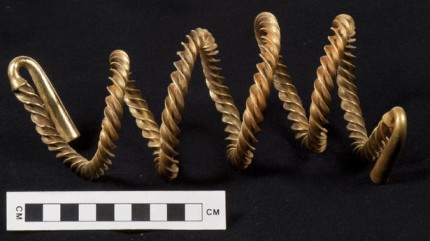Ronnie Johnston found something with his metal detector in a bog in Corrard, County Fermanagh in December of 2009. He thought the twisted metal rope was a suspension spring for a vintage car. He took it home, rinsed it off, put it in a drawer and thought nothing more of it for the next two years. Then, in May of 2011, he saw a picture of a torc in a treasure hunting magazine and realized that his nifty spring might be something altogether more important.
By Irish law, anyone who discovers something he has reasonable grounds to believe is treasure must report it to the coroner within two weeks. Obviously Mr. Johnston missed the boat a little on compliance with the Coroners Act of 1959, but as soon as he realized his car spring might be a gold torc, he called an expert from the Armagh County Museum to examine it. Dr. Greer Ramsey suggested it be reported to the authorities as a potential treasure find and so it was.
On Friday, March 30th, the Coroner’s Court in Belfast held a treasure trove inquest. Experts testified that it is indeed an ancient torc made of 87% gold and 11% silver. The style, a four-flanged design that is twisted into a spiral, is characteristic of the Middle Bronze Age, probably the Penard Period of metalworking, ca. 1300-1150 B.C. To make this style torc, the smith took a cast bar of gold then cut four lengthwise wedges into the bar creating a cross-shaped cross-section. Once the flanges were carved, the torc was twisted by turning the ends of the bar. Then the smith forged trumpet terminals out of each end of the bar.
It’s 37 inches long, so was probably worn around the waist rather than around the arm or neck as we tend to think of torcs. It was coiled before burial, perhaps to make it easier to bury in a smaller space, or perhaps to make it hard for someone else to uncoil it and wear it.
The coroner declared the torc treasure, the first official treasure that has been found in Northern Ireland in the last three years. Next up comes the valuation. The torc will be sent to the Treasure Valuation Committee at the British Museum in London. Experts will assess a fair market price for the piece. Since Johnston owns the field where he found the torc, any museum that purchases the artifact will pay him the valuation price.
The coroner, John Leckey, described the Corrard torc as an extremely beautiful object and stressed the importance of reporting such finds to the authorities.
“I would regard it as an outcry if the object didn’t end up in Northern Ireland on display in a museum. This is part of the culture of Ireland,” he said.
He added how Culture Minister Caral Ni Chuilin should be alerted to the immense significance of the find, describing it as “an important day for Northern Ireland”.
